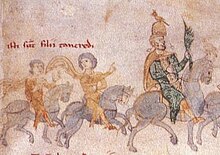William III of Sicily
| William III | |
|---|---|
 A near-contemporary depiction of William (far left) with his father (far right) and brother (middle). | |
| King of Sicily | |
| Reign | February – October 1194 |
| Coronation | January/February 1194 |
| Predecessor | Tancred |
| Successor | Constance & Henry I |
| Born | c. 1186 Palermo, Kingdom of Sicily |
| Died | c. 1198 Alt-Ems, Swabia, Holy Roman Empire |
| House | House of Hauteville |
| Father | Tancred, King of Sicily |
| Mother | Sibylla of Acerra |
William III (Italian: Guglielmo III; c. 1186 – c. 1198), a scion of the Hauteville dynasty, was the last Norman King of Sicily, who reigned briefly for ten months in 1194. He was overthrown by his great-aunt Constance and her husband Emperor Henry VI.
Life and reign
He was the second son of Count Tancred of Lecce and his wife Sibylla of Acerra. When in 1189 King William II of Sicily died childless, Tancred, an illegitimate son of the Norman duke Roger III of Apulia gained the support of Pope Clement III to be crowned King of Sicily, denying the rights of his aunt Constance, daughter of late King Roger II.
At the age of four, shortly after the death of his older brother Roger and, a few weeks later, of his father (20 February 1194), William was crowned king by Pope Celestine III in Palermo. His mother Sibylla acted as his regent.
However, Constance's husband, the Hohenstaufen emperor Henry VI claimed the throne of Sicily in right of his wife. Even before Tancred's death he had been laying plans to invade, and his resources had been further augmented by the ransom he had received for the release of King Richard I of England.
Overthrow and death


In August 1194 Henry marched against Sicily. Sibylla was unable to organize much effective resistance. By the end of October Henry had conquered all the mainland parts of the kingdom and crossed over into the island of Sicily. On 20 November Palermo fell, William and his mother fled to Caltabellotta Castle.
Henry offered Sibylla generous terms: William was to retain the County of Lecce, the home territory of his father before he had become king, and was also to retain the Principality of Taranto in turn for renouncing the royal crown. With that agreement reached, William, his mother and his sisters watched while Henry was crowned King of Sicily on 25 December (Constance was not crowned due to being in labour with Henry's son Frederick II in Iesi). Nevertheless, four days later, an alleged conspiracy against the new king was uncovered, and many of the leading Italo-Norman political figures were arrested and sent to prison in Germany, including William and his family.
While his mother and sisters were eventually released and lived in obscurity in France, nothing is known for certain of William's subsequent fate. He is said to have been blinded,[i] castrated, or both. According to some sources he died in captivity at Alt-Ems Castle a few years later, others claim that he was released and became a monk. Another theory is that he later returned to Sicily under the alias Tancredi Palamara. Henry's son, Emperor Frederick II (who was also king of Sicily) discovered Tancredi Palamara in Messina and had him executed in 1232. However, referring to several letters by Pope Celestine III, the date generally accepted for his death is 1198. William's heir was his younger sister, whose precise name is unclear but has been given variously as Mary, Elvira, Albinia or Blanche.
References
- ^ The practice of blinding potential claimants to the throne and in this way rendering them ineligible is well-attested in the Byzantine Empire, which formerly ruled Sicily and retained some involvement in the island's affairs.
